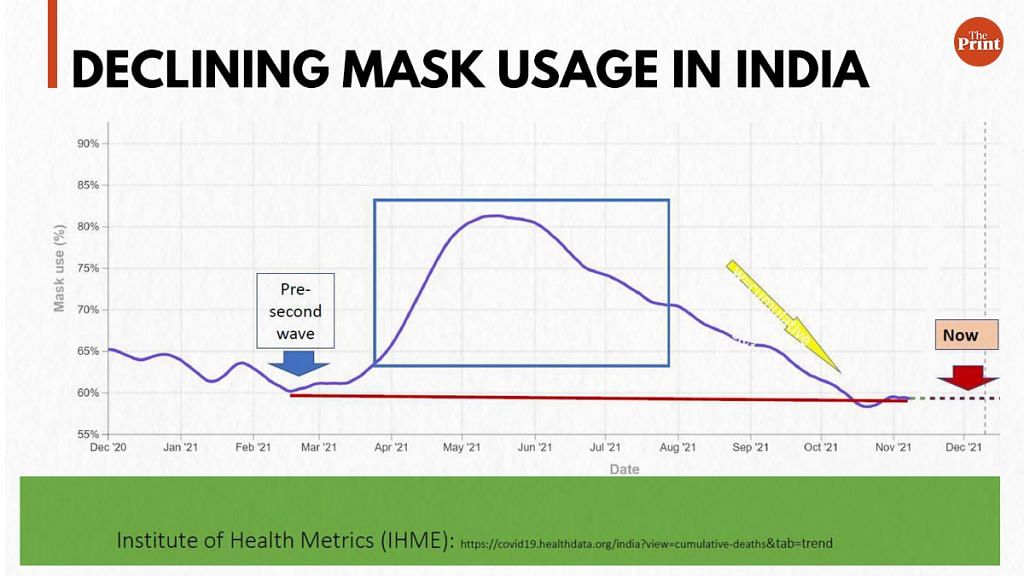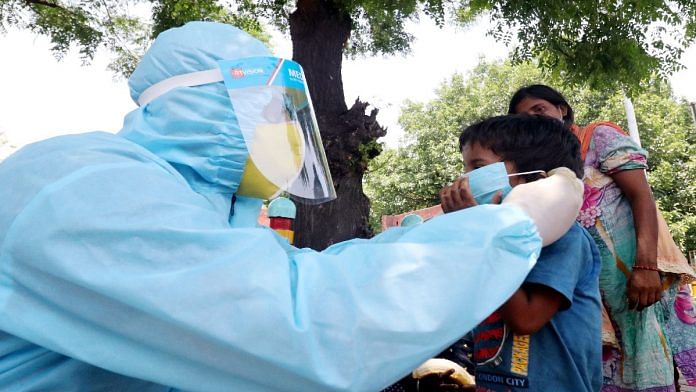New Delhi: Mask usage in India has dipped to under 60 per cent, the lowest since December 2020, NITI Aayog member V.K. Paul said at the weekly Covid health briefing Friday.
Calling it a “reality check”, Paul quoted data from the Institute of Health Metrics (IHME), sharing a graph that showed how fewer people were resorting to wearing masks. The figures come amid mounting global concern over the Omicron variant of the coronavirus.
According to the data, at the start of December last year, mask usage was just about 65 per cent.

As the number of active cases in the country went down, so did the use of masks — dropping to around 60 per cent by mid-February 2021, the data showed. However, as active cases started increasing, so did mask usage.
Use of masks peaked — over 80 per cent — between May and June this year, around the same time that India’s devastating second Covid wave wreaked havoc.
“According to this estimate, we are worse off now than we were before the last surge in Covid cases. From this point of view of protection, we are operating at an unacceptably low level of mask usage,” Paul said.
The NITI Aayog member said such “collective carelessness” had cost us dearly in the past.
“The scientific community is constantly warning that it is not yet time to get rid of our masks,” Paul added.
The mask is a “universal social vaccine”, which needs to be worn even when a person has been vaccinated, said Lav Agarwal, joint secretary in the health ministry.
Agarwal pointed out that a number of districts in Mizoram, Kerala and Sikkim have Covid test positivity of more than 10 per cent, indicating that the infection was spreading in these districts.
The South Sikkim district, he said, had the highest test positivity of 25.78 per cent. Hnahthial district of Mizoram had a high positivity as well, 22.10 per cent.
Agarwal also noted that as many as 25 cases of the Omicron variant had been reported from five states in India — which is around 0.04 per cent of the total cases involving different variants of concern circulating in the country.
Ten Omicron cases have been detected in Maharashtra, nine in Rajasthan, three in Gujarat, two in Karnataka and one in Delhi. All patients have mild symptoms, Agarwal said.
Also Read: Only 2-3% see masks, distancing around them ahead of 2nd Covid Diwali, survey finds
‘Wrong addresses hampering contact tracing’
Agrawal also said that international travelers often give incorrect addresses after landing, making it difficult for authorities to contact them if they test positive.
“The entire process is to help us help you (the public). Be it Omicron, or any other variant, if we are able to give timely treatment to a patient, or isolate them, everyone’s families will be safer,” he said, appealing to travelers to not record incorrect destination addresses on landing.
Children’s vaccinations and booster doses
On the status of vaccinations for children, Paul said that the National Technical Advisory Group on Immunisation in India (NTAGI) is looking at emerging data on the same.
“We do not have enough information on children’s vaccination yet. They are examining other facets of the vaccines. When a decision point is reached and a recommendation is given by them, it will be acted on appropriately,” he added.
Asked about plans for booster doses in India, Balram Bhargava, director general at the Indian Council for Medical Research (ICMR), explained that there are three aspects to immune response — antibody response, cellular immunity and mucosal immunity.
Both cellular immunity and mucosal immunity are relatively harder to measure and track, but antibody response can be easily measured, he said.
“Antibody levels remain high for upto nine months, according to several studies, after which the levels come down. But this does not mean that the vaccine becomes ineffective after nine months,” Bhargava added.
V.K. Paul said the World Health Organisation (WHO) has not yet given any recommendations for booster doses. “WHO has clearly and emphatically highlighted the need to complete vaccination as the most important priority. Our approach is also aligned with the view that we should complete vaccinating every adult with two doses,” he added.
Paul said they are keeping a watch on the emerging science of mixing vaccines for better immune response.
Daily average vaccination rate increased in December
Agarwal pointed out that 86.2 per cent of the adult population had received one dose of the vaccine, while 53.5 per cent of the population has been fully vaccinated.
He added that while the average number of daily vaccine doses during the festive months of October and November had reduced to 55.77 lakh and 59.33 lakh doses respectively, the same had increased to 78.66 lakh once again in the month of December.
This is similar to the daily average of 78.69 lakh doses in September.
(Edited by Gitanjali Das)
Also Read: Wear masks like we wear shoes, PM Modi said. Here are 10 times his ministers ignored request






